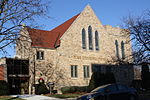Sheboygan Armory
Basketball venues in WisconsinBuildings and structures in Sheboygan, WisconsinDefunct indoor arenas in WisconsinDemolished sports venues in WisconsinFormer National Basketball Association venues ... and 5 more
National Basketball League (United States) venuesNational Register of Historic Places in Sheboygan County, WisconsinSheboygan Red SkinsStreamline Moderne architecture in WisconsinUse mdy dates from November 2020

Sheboygan Municipal Auditorium and Armory (commonly known as the Sheboygan Armory) was a 52,000 sq. ft indoor arena located on the lakefront in Sheboygan, Wisconsin. It was built in Streamline Moderne style in 1941 as a Works Progress Administration project. The building seated 3,974 with permanent balcony seating and bleacher seating on the floor level. It was listed on the National Register of Historic Places in 2019. It was razed in 2020.
Excerpt from the Wikipedia article Sheboygan Armory (License: CC BY-SA 3.0, Authors, Images).Sheboygan Armory
Center Avenue, Sheboygan
Geographical coordinates (GPS) Address Nearby Places Show on map
Geographical coordinates (GPS)
| Latitude | Longitude |
|---|---|
| N 43.750277777778 ° | E -87.705277777778 ° |
Address
Center Avenue 249
53081 Sheboygan
Wisconsin, United States
Open on Google Maps









